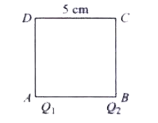Find Vba, if 12J of work has to be done against an electric field to take a charge of 10−2 C from a to b.
120V
−250V
1200V
−120V
The correct Answer is:C
Wab=△Ua−b=Ub−Ua=q(Vb−Va)=qVba
:Vba=Wabq=1210−2=1200V
Topper's Solved these Questions
- BOOK - DC PANDEYCHAPTER - ELECTROSTATICSEXERCISE - Exercise 24.62videos
ELECTROSTATICS
- BOOK - DC PANDEYCHAPTER - ELECTROSTATICSEXERCISE - Exercise 24.72videos
ELECTROSTATICS
- BOOK - DC PANDEYCHAPTER - ELECTROSTATICSEXERCISE - Exercise 24.44videos
ELECTROSTATICS
- BOOK - DC PANDEYCHAPTER - ELECTROSTATIC POTENTIAL AND CAPACITORSEXERCISE - (C) Chapter exercises50videos
ELECTROSTATIC POTENTIAL AND CAPACITORS
- BOOK - DC PANDEYCHAPTER - GRAVITATIONEXERCISE - All Questions120videos
GRAVITATION
Similar Questions
12 j of work has to be done against an existion electric field to take a charge of 0.01 C from A to B. How much is th potential difference VBVA?
View Solution20 J of work has to be done against an existing electric field to take a charge of 0.05 C from A to B. How much is the potential difference VB−VA ?
View Solution
Knowledge Check
- Question 1 - Select One
15 joule of work has to be done against an existing electric field to take a charge of 0.01 C from A to B. Then the potential difference (VB−VA) is :-
A1500 voltB−1500 voltC0.15 voltDnone of these - Question 2 - Select One
If 50 joule of work must be done to move an electric charge of 2 C from a point, where potential is -10V to another point where potential is V volt, the value of V is
A+5VB−15VC+15VD+10 V
Charges 2×10−6Cand1×10−6C are placed at comers A and B of a square of side 5 cm as shown in the figure. How much work will be done against the electric field in moving a charge of 1×10−6C from C to D?
 View Solution
View SolutionIf 20J of work has to be done to move an electric charge of 4C from a point, where potential is 10V to another point, where potential is V volt, find the value of v.
View SolutionIn the above situation, calculate the work done against the electric field in moving the charge Q from the third vertex to the centroid of the triangle if charges -q and +q are placed on both the vertices of the equilateral triangle.
View SolutionA charge is moved in an electric field of a fixed charge distribution from point A to another point B slowly. The work done by external agent in doing so is 100J . What is the change in potential energy of the charge as it moves from A to B ? What is the work done by the electric field of the charge distribution as the charge moves from A to B ?
View SolutionIn an uniform electric field of strength E, a charge particle Q moves point A to point B in the direction of the field and back from B to A. Calculate the ratio of the work done by the electric field in taking the charge particle from A to B and from B to A.
View SolutionIf 100 J of work must be done to move electric charge equal tp 4C from a place where potential is −10V to another place where potential si V volt, find the value of V.
View Solution

